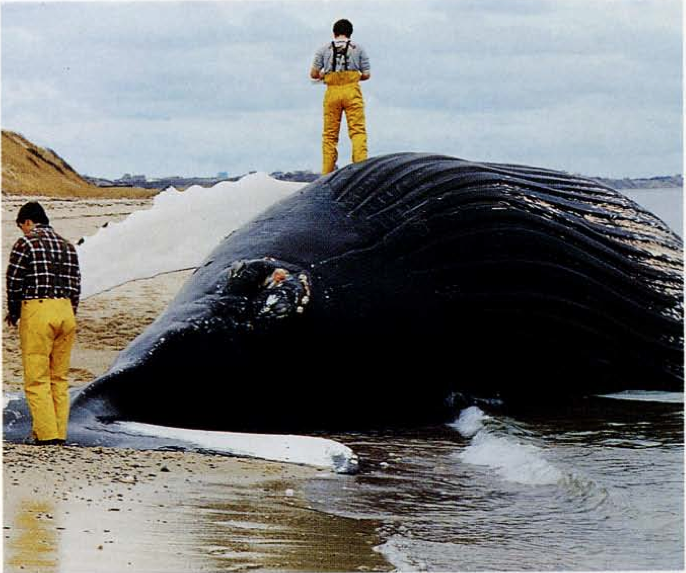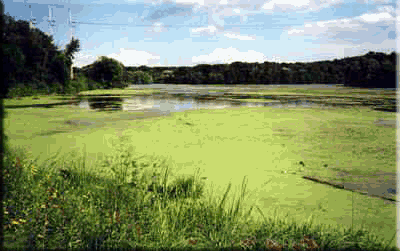Stunning Critters, Silent Killers
Science students (like me) and research scientists are often attracted to the aesthetic beauty of the physical and natural sciences at both the microscopic and the macroscopic level. Oscar Wilde quite vividly noted, “Life imitates art far more than art imitates life.” While many art critics may raise eyebrows to the notion that microorganisms form a distinct genre of art, us scientists rebut (per usual) with this artistic rendition of San Diego beaches using differently fluorescing bacteria:

But “life imitating art” is not restricted to recombinantly engineered bacteria that fluoresce different colors. Other forms of microscopic life are just as beautiful, albeit much more mysterious and catastrophic than the harmless “garden-variety” bacteria that scientists use for everyday experiments. It is usually the mysterious and the life-threatening natural phenomena (i.e. tsunamis, tornados, violent thunderstorms) that pique people’s consciences. Many find an eerie beauty within episodes of these catastrophic events—hundreds of storm-chasers literally run into the belly of the beast when they purposefully follow life-threatening storms. Some chasers seek a thrilling adventure, and many others are just enchanted by the beauty of horrific phenomena.
Horrific phenomena find a way into the biological world through the breathtaking phenomenon commonly known as “red tide,” an event caused by special species of algae. Most people who have heard of red tides usually have the misconception that these algal blooms always have devastating consequences. But not all red tides are harmful, which consequently has resulted in scientists distinguishing red tides (which may or may not be toxic to aquatic life) from harmful algal blooms, or HABs (which are undeniably harmful, but may or may not be colorful).


While most algae are not harmful, a small percentage of these microorganisms do pose significant environmental and health concerns to coastal communities. There are two main ways in which these rare algal species are particularly harmful.
Saxitoxin Toxicity
The first method directly kills aquatic life through toxic buildup. What causes these rapid algal blooms? A bloom occurs when a single-celled algae rapidly divides by simple asexual reproduction when nutrient resources are abundant. Although it is not entirely clear what exactly triggers these events, the consequences are well known. Harmful algal blooms are notorious for killing tens of thousands of marine animals that ingest the potent algae synthesized neurotoxin, saxitoxin (STX). Cases have been reported off the coast of Cape Cod, where the algal bloom of the species Alexandrium fundyense caused a mass death of a dozen humpback whales that accumulated lethal doses of saxitoxin. Just last week, tens of thousands of fish died due to a HAB along the Clifton shore in Karachi, Pakistan.
Saxitoxin causes paralysis, and even death if exposed to high enough quantities. Saxitoxin acts by blocking sodium channels in nerve cells. Sodium and potassium channels are essential for normal neuronal function—i.e. they help relay important sensory information to the brain. If sodium channels are blocked, nerve cells are unable to fire, eventually resulting in paralysis or death. Although saxitoxin is extremely toxic, affected dead fish do not accumulate high enough levels of toxins to have a lethal effect on humans who eat seafood. However, the potent toxin has made its way onto the United States military’s list of chemical weapons, which poses ethical questions about its potential misuse.
Eutrophication: Oxygen Depletion
The second way in which algae populations can threaten life is indirectly through the eutrophication of bodies of water. Lazy pet goldfish owners likely may have witnessed this unfortunate event. When algae build up rapidly in a body of water (such as a fish tank) due to the high availability of nutrients such as phosphorus, the algae deplete the oxygen supply for fish and other aquatic organisms. Over time, if the algae is not cleaned or eaten by other species, the fish suffocate and die due to a lack of oxygen. This unfortunate eutrophication event happened a few years ago to the beautiful Batiquitos Lagoon in my very own hometown of Carlsbad, CA (don’t worry, this story has a happy ending. The City of Carlsbad worked hard to fix the issue).

At the same time, algae can be a double-edged sword. It is important to note that most microscopic life—including many types of algae—is not hazardous, but rather a vital component of the ocean food network, in which they act as a source of food for fish and other aquatic animals. In fact, to make sure I don’t belittle the importance of algae, some scientists propound that over 80% of the earth’s atmosphere can be attributed to the photosynthetic blue-green algae (AKA cyanobacteria).

Nevertheless, harmful algal blooms continue to occur sporadically. While visually spectacular, they threaten aquatic as well as land ecosystems. Not only do these episodes wreak biological damage, they have costly economic consequences as well. For example, it is estimated by the Woods Hole Oceanographic Institution that the potential magnitude of economic losses due to harmful algal blooms in Australia alone are close to $200 million in US dollars annually. This is truly devastating for fisheries that suffer a bad rep once customers lack confidence in the quality of fish.
As of now, there really isn’t much we can do to prevent harmful algal blooms, but governments are now accustomed to quickly take action if there were ever to be one in the near future. When that visually spectacular phenomenon does occur, make sure to witness the natural enigma and thank the microscopic world for its special contribution to a uniquely natural art form.
Prashant is a senior undergraduate student studying biochemistry and molecular biology at the University of California, Berkeley. He currently is Editor-in-Chief of Berkeley Scientific Journal, where he became interested in science journalism and its propensity to motivate general audiences. Follow BSJ on Twitter.

This is a very interesting article. You bring up a great point. There are many things in the world that exist which have harmful effects for some elements but for others are beneficial. This makes one wonder whether to curtail these “silent killers.”
Really nice post thanks for the info! 🙂